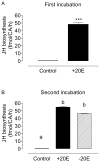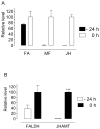20-Hydroxyecdysone stimulation of juvenile hormone biosynthesis by the mosquito corpora allata
- PMID: 26255691
- PMCID: PMC4558257
- DOI: 10.1016/j.ibmb.2015.08.001
20-Hydroxyecdysone stimulation of juvenile hormone biosynthesis by the mosquito corpora allata
Abstract
Juvenile hormone III (JH) is synthesized by the corpora allata (CA) and plays a key role in mosquito development and reproduction. JH titer decreases in the last instar larvae allowing pupation and metamorphosis to progress. As the anti-metamorphic role of JH comes to an end, the CA of the late pupa (or pharate adult) becomes again "competent" to synthesize JH, which plays an essential role orchestrating reproductive maturation. 20-hydroxyecdysone (20E) prepares the pupae for ecdysis, and would be an ideal candidate to direct a developmental program in the CA of the pharate adult mosquito. In this study, we provide evidence that 20E acts as an age-linked hormonal signal, directing CA activation in the mosquito pupae. Stimulation of the inactive brain-corpora allata-corpora cardiaca complex (Br-CA-CC) of the early pupa (24 h before adult eclosion or -24 h) in vitro with 20E resulted in a remarkable increase in JH biosynthesis, as well as increase in the activity of juvenile hormone acid methyltransferase (JHAMT). Addition of methyl farnesoate but not farnesoic acid also stimulated JH synthesis by the Br-CA-CC of the -24 h pupae, proving that epoxidase activity is present, but not JHAMT activity. Separation of the CA-CC complex from the brain (denervation) in the -24 h pupae also activated JH synthesis. Our results suggest that an increase in 20E titer might override an inhibitory effect of the brain on JH synthesis, phenocopying denervation. All together these findings provide compelling evidence that 20E acts as a developmental signal that ensures proper reactivation of JH synthesis in the mosquito pupae.
Keywords: 20-Hydroxyecdysone; Biosynthesis; Corpora allata; Juvenile hormone; Mosquito.
Copyright © 2015 Elsevier Ltd. All rights reserved.
Figures







Similar articles
-
Ecdysis triggering hormone ensures proper timing of juvenile hormone biosynthesis in pharate adult mosquitoes.Insect Biochem Mol Biol. 2014 Nov;54:98-105. doi: 10.1016/j.ibmb.2014.09.006. Epub 2014 Sep 23. Insect Biochem Mol Biol. 2014. PMID: 25257939 Free PMC article.
-
Coordinated changes in JH biosynthesis and JH hemolymph titers in Aedes aegypti mosquitoes.J Insect Physiol. 2015 Jan;72:22-27. doi: 10.1016/j.jinsphys.2014.11.003. Epub 2014 Nov 22. J Insect Physiol. 2015. PMID: 25445664 Free PMC article.
-
Stimulation of JH biosynthesis by the corpora allata of adult female Aedes aegypti in vitro: effect of farnesoic acid and Aedes allatotropin.J Exp Biol. 2003 Jun;206(Pt 11):1825-32. doi: 10.1242/jeb.00371. J Exp Biol. 2003. PMID: 12728004
-
Hormonal regulation of insect metamorphosis with special reference to juvenile hormone biosynthesis.Curr Top Dev Biol. 2013;103:73-100. doi: 10.1016/B978-0-12-385979-2.00003-4. Curr Top Dev Biol. 2013. PMID: 23347516 Review.
-
Nutritional regulation of JH synthesis: a mechanism to control reproductive maturation in mosquitoes?Insect Biochem Mol Biol. 2004 Jul;34(7):687-93. doi: 10.1016/j.ibmb.2004.03.021. Insect Biochem Mol Biol. 2004. PMID: 15242710 Review.
Cited by
-
Higher temperature accelerates the aging-dependent weakening of the melanization immune response in mosquitoes.PLoS Pathog. 2024 Jan 10;20(1):e1011935. doi: 10.1371/journal.ppat.1011935. eCollection 2024 Jan. PLoS Pathog. 2024. PMID: 38198491 Free PMC article.
-
Steroid hormone ecdysone deficiency stimulates preparation for photoperiodic reproductive diapause.PLoS Genet. 2021 Feb 2;17(2):e1009352. doi: 10.1371/journal.pgen.1009352. eCollection 2021 Feb. PLoS Genet. 2021. PMID: 33529191 Free PMC article.
-
Omics approaches to study juvenile hormone synthesis.Curr Opin Insect Sci. 2018 Oct;29:49-55. doi: 10.1016/j.cois.2018.05.013. Epub 2018 May 26. Curr Opin Insect Sci. 2018. PMID: 30551825 Free PMC article. Review.
-
Antagonistic actions of juvenile hormone and 20-hydroxyecdysone within the ring gland determine developmental transitions in Drosophila.Proc Natl Acad Sci U S A. 2018 Jan 2;115(1):139-144. doi: 10.1073/pnas.1716897115. Epub 2017 Dec 18. Proc Natl Acad Sci U S A. 2018. PMID: 29255055 Free PMC article.
-
Genetic tools to study juvenile hormone action in Drosophila.Sci Rep. 2017 May 18;7(1):2132. doi: 10.1038/s41598-017-02264-4. Sci Rep. 2017. PMID: 28522854 Free PMC article.
References
-
- Adams ME, Kim YJ, Park Y, Žitňan D. Developmental Peptides: ETH, Corazonin, and PTTH. In: Kastin Abba J., editor. Handbook of Biologically Active Peptides. 2. Vol. 33. Academic Press; 2013. pp. 222–228.
Publication types
MeSH terms
Substances
Grants and funding
LinkOut - more resources
Full Text Sources
Other Literature Sources
Research Materials

